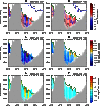Accelerated freshening of Antarctic Bottom Water over the last decade in the Southern Indian Ocean
- PMID: 28138548
- PMCID: PMC5266476
- DOI: 10.1126/sciadv.1601426
Accelerated freshening of Antarctic Bottom Water over the last decade in the Southern Indian Ocean
Abstract
Southern Ocean abyssal waters, in contact with the atmosphere at their formation sites around Antarctica, not only bring signals of a changing climate with them as they move around the globe but also contribute to that change through heat uptake and sea level rise. A repeat hydrographic line in the Indian sector of the Southern Ocean, occupied three times in the last two decades (1994, 2007, and, most recently, 2016), reveals that Antarctic Bottom Water (AABW) continues to become fresher (0.004 ± 0.001 kg/g decade-1), warmer (0.06° ± 0.01°C decade-1), and less dense (0.011 ± 0.002 kg/m3 decade-1). The most recent observations in the Australian-Antarctic Basin show a particularly striking acceleration in AABW freshening between 2007 and 2016 (0.008 ± 0.001 kg/g decade-1) compared to the 0.002 ± 0.001 kg/g decade-1 seen between 1994 and 2007. Freshening is, in part, responsible for an overall shift of the mean temperature-salinity curve toward lower densities. The marked freshening may be linked to an abrupt iceberg-glacier collision and calving event that occurred in 2010 on the George V/Adélie Land Coast, the main source region of bottom waters for the Australian-Antarctic Basin. Because AABW is a key component of the global overturning circulation, the persistent decrease in bottom water density and the associated increase in steric height that result from continued warming and freshening have important consequences beyond the Southern Indian Ocean.
Keywords: AABW; Antartica; Calving; Changes; Iceberg; Salinity; T-S Properties; Water Masses; abyss; climate change.
Figures






References
-
- Bindoff N. L., Hobbs W. R., Deep ocean freshening. Nat. Clim. Chang. 3, 864–865 (2013).
-
- Whitworth T., III, Two modes of bottom water in the Australian-Antartic basin. Geophys. Res. Lett. 29, 17-1–17-3 (2002).
-
- Jacobs S. S., Bottom water production and its links with the thermohaline circulation. Antarct. Sci. 16, 427–437 (2004).
-
- Aoki S., Rintoul S. R., Ushio S., Watanabe S., Bindoff N. L., Freshening of the Adélie Land Bottom Water near 140°E. Geophys. Res. Lett. 32, L23601 (2005).
-
- Rintoul S. R., Rapid freshening of Antarctic Bottom Water formed in the Indian and Pacific oceans. Geophys. Res. Lett. 34, L06606 (2007).
LinkOut - more resources
Full Text Sources
Other Literature Sources

